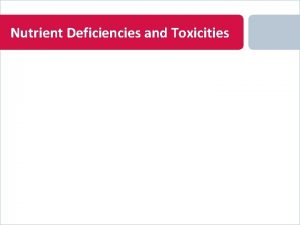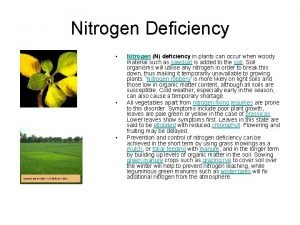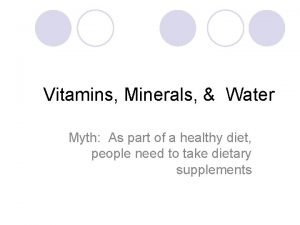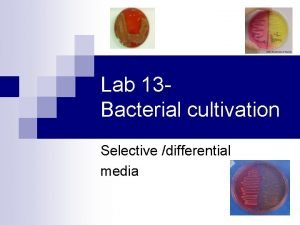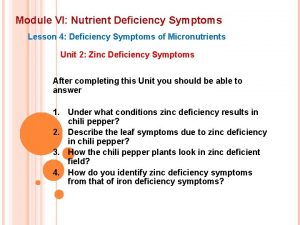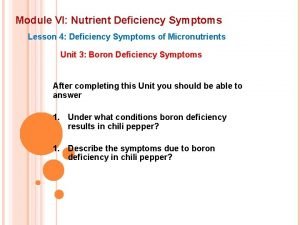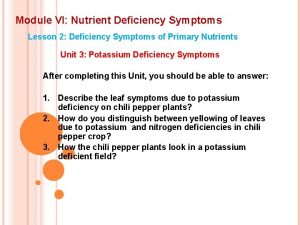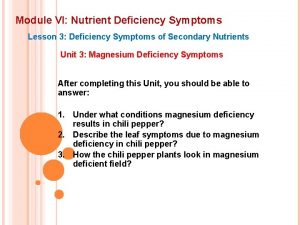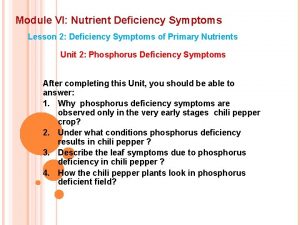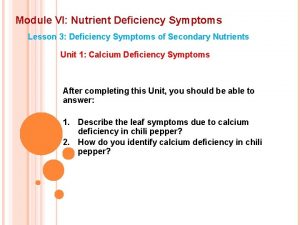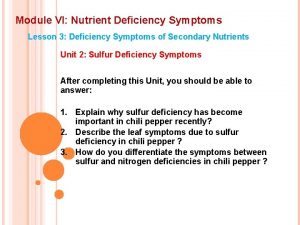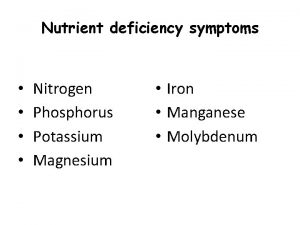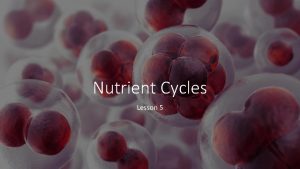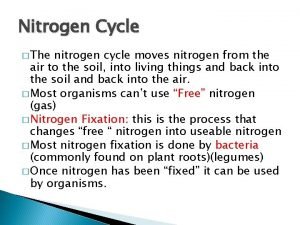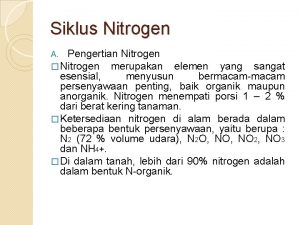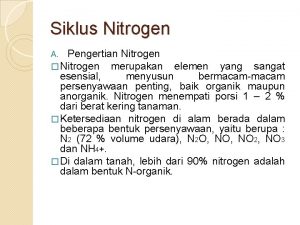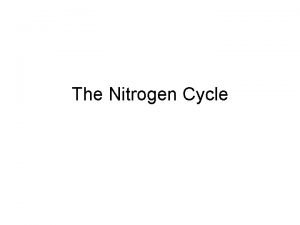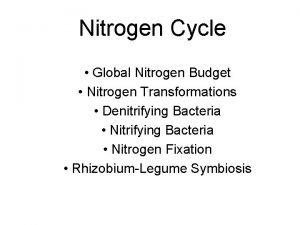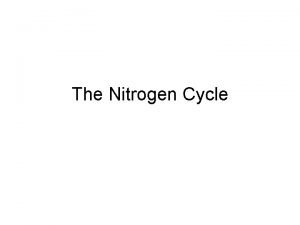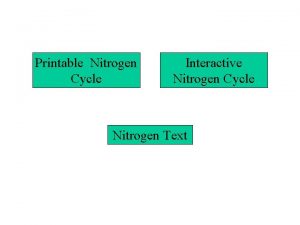Nutrient Deficiencies and Toxicities Nitrogen Deficiency on Chrysanthemum




























- Slides: 28

Nutrient Deficiencies and Toxicities

Nitrogen Deficiency on Chrysanthemum Uniform chlorosis of lower leaves turning to necrosis; stunting; chlorosis progressing up the plant

Nitrogen Deficiency on Turf Grass Nitrogen deficiency and toxicity and same turfgrass area due to the improper application of fertilizer.

Phosphorus Deficiency on Chrysanthemum After turning a deep green, lower leaves become chlorotic and then necrotic

Phosphorus Deficiency in Rose Leaves are generally stunted and may be graygreen

Potassium Deficiency in Rose Tip and marginal yellowing, browning and necrosis of older leaves.

Calcium Deficiency on Chrysanthemum Top leaves turn chlorotic in pattern and are incompletely formed (many tend to appear stripped like).

Calcium Deficiency in Roses Leaves become dull gray-green and bend down at margins, and edges later turn yellow and brown

Manganese Deficiency in Chrysanthemums Interveinal chlorsis starting at the top and progressing downward

Manganese Deficiency in Roses Interveinal chlorsis becomes necrotic

Magnesium Deficiency in Chrysanthemum Interveinal chlorosis of lower leaves

Iron Deficiency in Turfgrass Interveinal chlorosis caused by iron deficiency

Iron deficiency in Chrysanthemum Interveinal chlorosis starting at the top and progressing downwards

Iron Deficiency in Gardenia Foliar chlorosis on leaves of Gardenia

Iron Deficiency in Rhododendron Iron Chlorosis

Iron Deficiency on Roses Interveinal chlorosis in which main veins remain green

Copper Deficiency in Aglaonema Stunted and deformed new leaves

Molybdenum Deficiency in Poinsettia Leaf edge chlorosis and scorch

Molybdenum Deficiency in Chrysanthemum Blanched upper leaves

Fluoride Toxicity in Dracaena Fluoride toxicity in Dracaena with leaf damage

Fluoride Toxicity on Dracaena Severe Marginal Necrosis

Fluoride Toxicity in Dracaena Slight symptoms of fluoride toxicity grown under interiorscape conditions

Fluoride Toxicity in Calathea Marginal chlorosis and necrosis developing within 1 -2 weeks of treatment of soil drench of sodium fluoride

Fluoride Toxicity in Aglaonema Chlorotic and necrotic lesions

Salt Toxicity in Roses Marginal necrosis of leaves

Salt Toxicity in Geraniums Leaf edge necrosis caused by excessive levels of soluble salts in the growing medium

Salt Toxicity in Geraniums Wilted Geranium caused by root injury from an excessive levels of soluble salts in the growing mix

Salt Toxicity in Impatiens Defoliation resulting from excessive soluble salts
 Chrysanthemum lower classifications
Chrysanthemum lower classifications Peptone water
Peptone water Iron deficiency in roses
Iron deficiency in roses Nutrient deficiency in tomatoes
Nutrient deficiency in tomatoes Nitrogen sources
Nitrogen sources Alfred adler theory
Alfred adler theory Pampered style of life
Pampered style of life Minerals and their functions sources and deficiency chart
Minerals and their functions sources and deficiency chart Introduction of nutrients
Introduction of nutrients Wrist anastomosis
Wrist anastomosis How does deforestation affect the nutrient cycle
How does deforestation affect the nutrient cycle Six nutrient groups
Six nutrient groups Non fastidious definition microbiology
Non fastidious definition microbiology Emulsion egg dishes examples
Emulsion egg dishes examples Nutrient cycle in the serengeti
Nutrient cycle in the serengeti Deciduous woodland nutrient cycle
Deciduous woodland nutrient cycle Foods used in nutrition activities should be nutrient-dense
Foods used in nutrition activities should be nutrient-dense Brays nutrient mobility concept
Brays nutrient mobility concept Nutrient chain foldable
Nutrient chain foldable Which nutrient practice was best journey 2050
Which nutrient practice was best journey 2050 Nutrient basics
Nutrient basics Classification of nutrients and their functions
Classification of nutrients and their functions Journey 2050 student handout 3 crossword puzzle
Journey 2050 student handout 3 crossword puzzle Ecosystem term coined by
Ecosystem term coined by Balanced diet defination
Balanced diet defination Apes cycles
Apes cycles Lateral malleolar artery
Lateral malleolar artery Nutrient artery
Nutrient artery Tamoxifen nutrient depletion
Tamoxifen nutrient depletion


